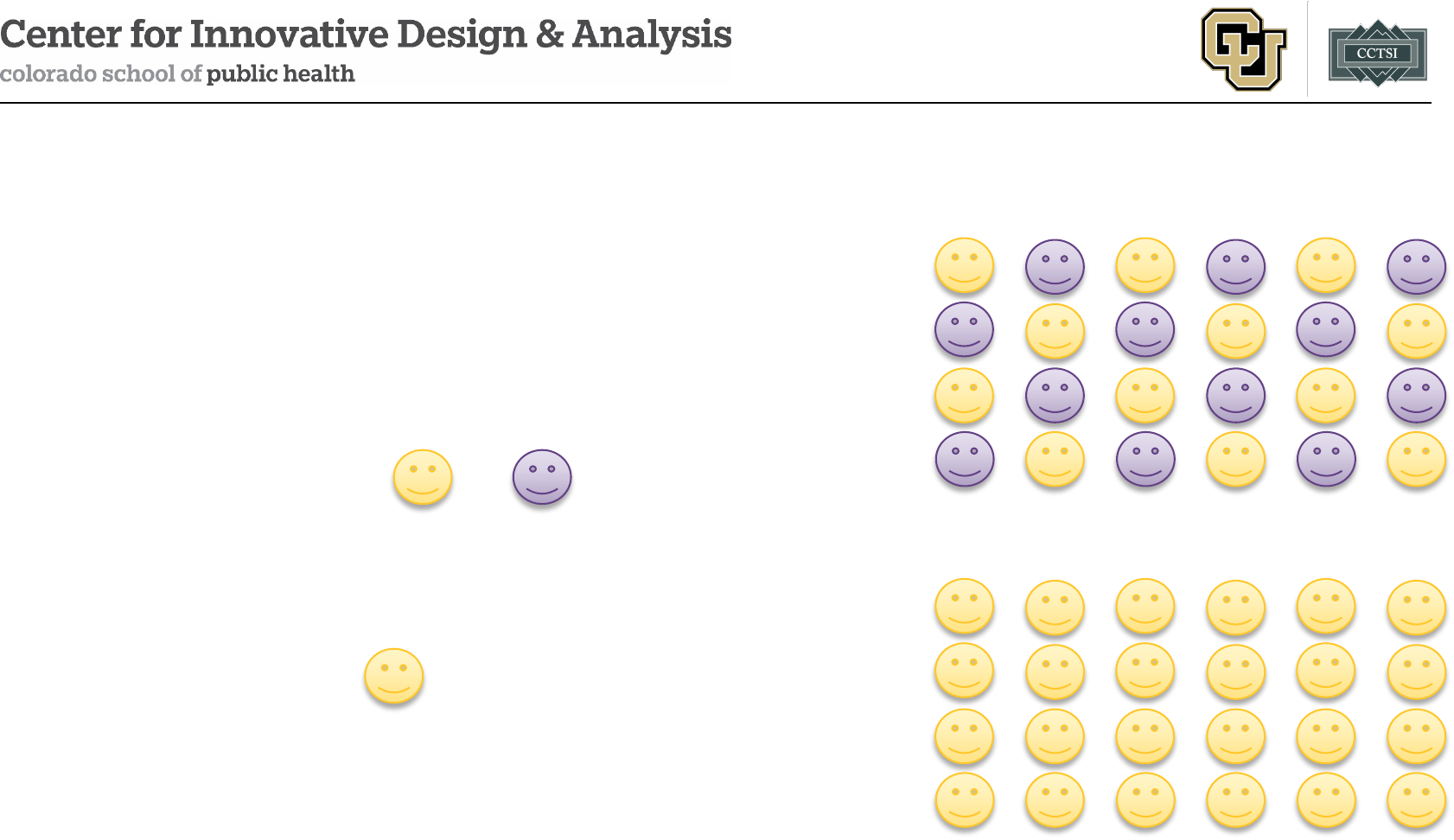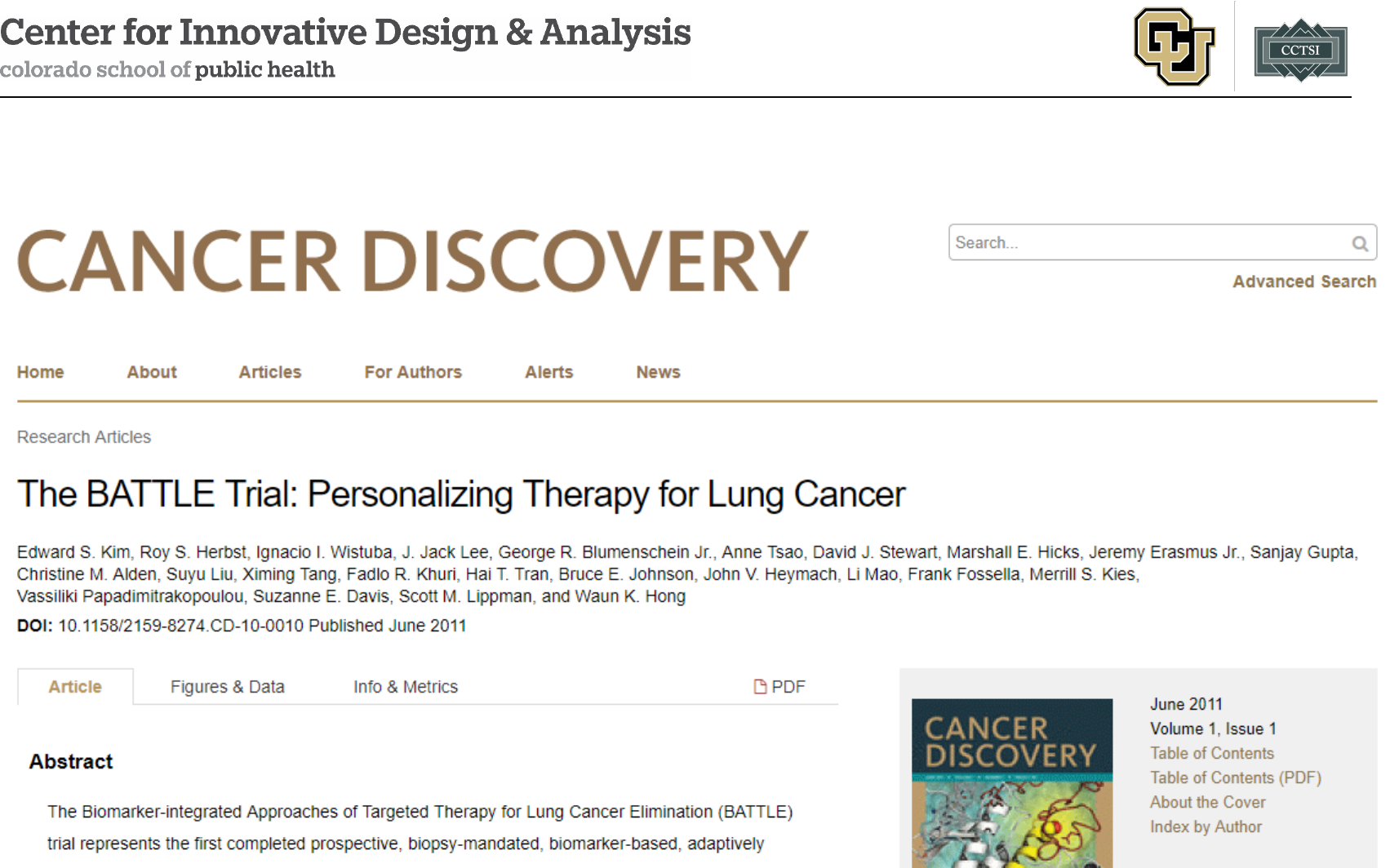
Adaptive Clinical Trials
From Basics to Bayesian
Alex Kaizer, PhD
June 5, 2019
ACCORDS Emerging Research Designs Conference

Outline
• What are adaptive designs?
• Adaptive design elements and examples
• Bayesian methods in adaptive trials
2

Adaptive Trial Designs
3

What are adaptive designs?
• The key to all my research woes!
• Designs where I can do whatever I want, whenever I want to
(ethically) answer my research questions.
• The “good” designs that statisticians have been selfishly keeping to
themselves all this time!
• “An adaptive design is defined as a clinical trial design that allows for
prospectively planned
modifications to one or more aspects of the
design based on accumulating data from subjects in the trial.” (FDA
2018 Adaptive Designs for Clinical Trials Guidance Document)
4

FDA Adaptive Elements
• Group sequential designs (i.e., interim analyses)
• Adaptations to sample size (i.e., sample size re-estimation based on interim
results to preserve power)
• Adaptations to the patient population (i.e., adaptive enrichment)
• Adaptations to treatment arm selection (i.e., adding or terminating arms)
• Adaptations to patient allocation (i.e., adaptive randomization)
• Adaptations to endpoint selection
• Adaptations to multiple design features (combining multiple features
above)
5

Sample Size Re-Estimation
Adaptations to Sample Size
6

Why Adapt the Sample Size?
Hypothetical Scenario:
• You design and power a study on a research
topic with limited prior information (i.e., there
is uncertainty in your sample size calculation
assumptions)
• As the study is being conducted, the observed
treatment effect is smaller than expected, but
still clinically meaningful
• If we maintain the planned sample size, we may
be underpowered to detect this difference
7
Image Source: Everyday Health

Sample Size Re-Estimation
• Using interim estimates we can address the prior uncertainty about
the treatment effect size
• These can be blinded or unblinded, however they involve different
statistical approaches and the FDA Guidance focuses primarily on the
unblinded context
• FDA recommends steps should be taken to limit personnel with
detailed knowledge to maintain trial integrity
• It can be challenging if the re-estimation suggests the need for a
much larger sample size
8

Trial Example
• Study powered for composite
event rates of 5.1% vs. 3.9% in
study arms 10,900 patients
for 85% power and two-sided
α=0.05
• Unblinded sample size re-
estimation planned after 70%
enrolled
• At the interim analysis, an early
stopping efficacy boundary was
crossed but DSMB decided to
continue the trial as planned
(i.e., no sample size increase)
9

Adapting the Patient Population
Adaptive Enrichment
10

Why “Enrich” the Patient Population?
Hypothetical Scenario:
• You expect the treatment effect to be
greater in a certain targeted subset of the
trial population: >
• Do we enroll only the targeted
subpopulation?
11

Reasons for Population Enrichment
• Want information about both the targeted and non-targeted
subpopulations
• Uncertain about treatment effect in non-targeted subpopulation (i.e.,
perhaps the treatment is as effective or less effective but still clinically
meaningful)
• Can provide greater power relative to a fixed sample design without
enrichment (i.e., if we restrict enrollment we have more
subpopulation observations versus having equivalent power)
12

Simple Enrichment Example
13
1. Enroll both groups at start
2. At interim analysis,
determine if you
continue enrollment in
the overall population
or restrict future
enrollment to the
targeted
subpopulation.
3a. Continue enrollment of both
3b. Restrict enrollment to subpop.

Seamless Designs
Adaptations to Treatment Arm Selection
14

Seamless Designs
• Seamless study designs combine multiple phases of a study into one
trial
• e.g., Phase II and Phase III combined to include both treatment selection and
confirmation in one trial
• Interim analyses used to determine what continues from Phase II
portion of the study to Phase III
• Advantages include reducing overall study size, shorter development
time, more long term safety information
• Disadvantages include logistical challenges and issues maintaining
statistical properties
15

One Version of Seamless Phase II/III Designs
16
• Compare Treatment 1 and 2 after Phase II and drop least effective arm.
• Then compare efficacy after Phase III between the SOC and continued
treatment using all data from Phases II and III.

Multi-Arm Multi-Stage
MAMS can drop ineffective arms
early on at an interim analysis.
Promising arms seamlessly
continue to a (confirmatory)
Phase III trial.
One disadvantage is that you can
only compare “Novel” arms to
the Control arm (to maintain the
type I error and power).
17

Adaptive Randomization
Adaptations to Patient Allocation
18

Baseline (Covariate) Adaptive Randomization
• The probability of the next treatment assignment is altered on the
basis of the previous assignments in order to achieve better balance
(i.e., biased coin, minimization procedures).
• Considerations:
• How to implement (central entity vs. local entities)
• Multiple treatments
• What is considered a lack of balance
• What covariates to use for balance
• Main advantage: opportunity to balance composition of treatment
groups on several characteristics without stratification
19

Response/Outcome Adaptive Randomization
• Assignment probabilities are modified based on observed responses
or outcomes
• The motivation is to allocate as many patients as possible to the
“best” treatment arm
• Recent research has identified that outcome adaptive randomization
may result in randomization to the inferior arm, concerns about
sample size imbalance (leading to reduced power), and challenges
where time effects are present
20

Response Adaptive Randomization Example
Zelen’s 1969 Play the Winner Design (2 arm study):
1. Assign 1
st
participant to either arm with equal probability
2. Observe success/failure in arm
3. Depending on outcome…
1. Observed success leads to use increasing the probability of the successful
treatment being assigned for the next participant
2. Observed failure leads to a decreased probability
Disadvantages are that sample size/power is challenging to calculate a
priori and you need to know the previous response before randomizing
the next individual (although you could update in blocks)
21

Master Protocol Designs
Umbrellas, Baskets, and Platforms
22

23

Master Protocols
• Traditionally we have conducted separate standalone studies for at
most a few interventions in targeted populations, however these are
becoming increasingly expensive and prohibitive
• Precision medicine and the need for flexible designs to consider
multiple drugs, diseases, populations, or combinations of these are
needed
• Master protocols provide a unifying framework that use one master
protocol for a study that is designed to answer multiple questions
24

MP Innovation
• Woodcock and LaVange
describe the many areas of
innovation that can be found
in master protocols
25

General Types of Master Protocols
26

Umbrellas and Baskets
27
Umbrella trials identify a single
(broad) disease, but then
further classified by subtypes
and treated accordingly
Basket trials identify a common
mutation (or trait) across sites
and then treat all with a
common intervention

28
Another example
figure of basket
and umbrella
designs (Figure 1
from Woodcock
and LaVange)

Platform Trials
29
Platform designs
can be very
flexible and
potentially
complex (Figure 2
from Woodcock
and LaVange)

Master Protocols
• Designs can be noncomparative or comparative
• If comparative, you may have a common control group or multiple control
groups depending on design
• Designs can include adaptive elements or not
• Designs can be exploratory or confirmatory
• LOTS of flexibility
30

Umbrella Trial Example
31

Umbrella Example: Study Design (BATTLE-1)
• Outcome was complete or partial response, stable disease,
progression free survival, overall survival, toxicity
• Phase II, single-center, comparative trial with (response) adaptive
randomization
• Four therapies (three mono and one combination)
• Study enrolled advanced NSCLC with specific mutations
• 255 adults who had at least 1 failed chemotherapy regimen
32

33
Umbrella Example cont.

Umbrella Example: Conclusion
• Demonstrated the feasibility of the umbrella design to advance
personalized treatment of NSCLC
• Different responses by mutation type and status:
34

Platform Trial Example
35

West Africa Ebola Virus Disease Outbreak
36

Platform Example: PREVAIL II
• No known candidate therapies or vaccines for Ebola
• Outcome was 28-day mortality
• Design sequentially considered multiple treatments within a single
trial to most effectively identify beneficial therapeutics
• Used a Bayesian design with frequent interim monitoring (starting
after 12 participant outcomes observed, 6 per arm)
• Used Haybittle-Peto style boundaries for interim monitoring based on
the posterior probability of the experimental treatment being better
than the current standard of care
37

PREVAIL II Example Design
38
Due to concerns
with time effects,
only concurrent
controls were
used in analyses
(i.e., only
information within
each segment).

PREVAIL II Conclusion
• Terminated early due to success of public health measures, which
prevented desired enrollment of 100 per arm in first segment
• Patients in treatment arm had lower 28-day mortality rate (22% vs.
37%), but it did not meet the prespecified statistical threshold for
efficacy
• Did demonstrate minimal safety concerns with the intervention
39

Extension to Incorporate Past Information
40
Use methods to
incorporate past
segments when
“exchangeable” (i.e.,
potentially use non-
concurrent data)
Adaptively randomize
to maintain
information balance
between oSOC and
Experimental arms

Bayesian Methods in Adaptive
Designs
A Brief Introduction
41

A Brief Note on Frequentist vs. Bayesian Designs
“Everyone is Bayesian in the design phase” (i.e., power, type I error,
effect size, etc. are usually based on prior studies or evidence)
42

Bayesian Adaptive Design
Essentially, any designs that use Bayesian approaches for statistical
reasoning and/or calculations, with some examples being:
• Use of predictive statistical modeling
• Use of assumed (prior) dose-response relationships to govern dose
escalation and selection
• Borrowing information from external sources (e.g., previous trials,
natural history studies, registries) via informative prior distributions
• Use of posterior probability distributions to form trial success criteria
(as opposed to frequentist p-values)
43

Design Considerations
• The FDA requires that all trials maintain desired frequentist operating
characteristics, including Bayesian trials:
• Power
• Type I error rate
• Evaluating trial operating characteristics generally involves extensive
simulation studies (i.e., this is how you calculate power, the target
sample size, etc.)
• Prior specification can be challenging (e.g., conjugate priors,
informative priors, vague priors, etc.)
44

45
Source: xkcd.com #1132

Should I consider adaptive designs?
Advantages
• Improved flexibility
• More efficient use of resources
(financial and administrative)
• Greater statistical power
possible
• Ability to answer broader
questions that may be refined as
the trial progresses
Challenges
• Advanced analytic methods
needed to avoid type I errors
• Gains in efficiency have trade-
offs with other trial components
• Logistics to maintain trial
conduct and integrity
• Adaptations may be limited by
clinical/scientific constraints
46

Thank you!
47
